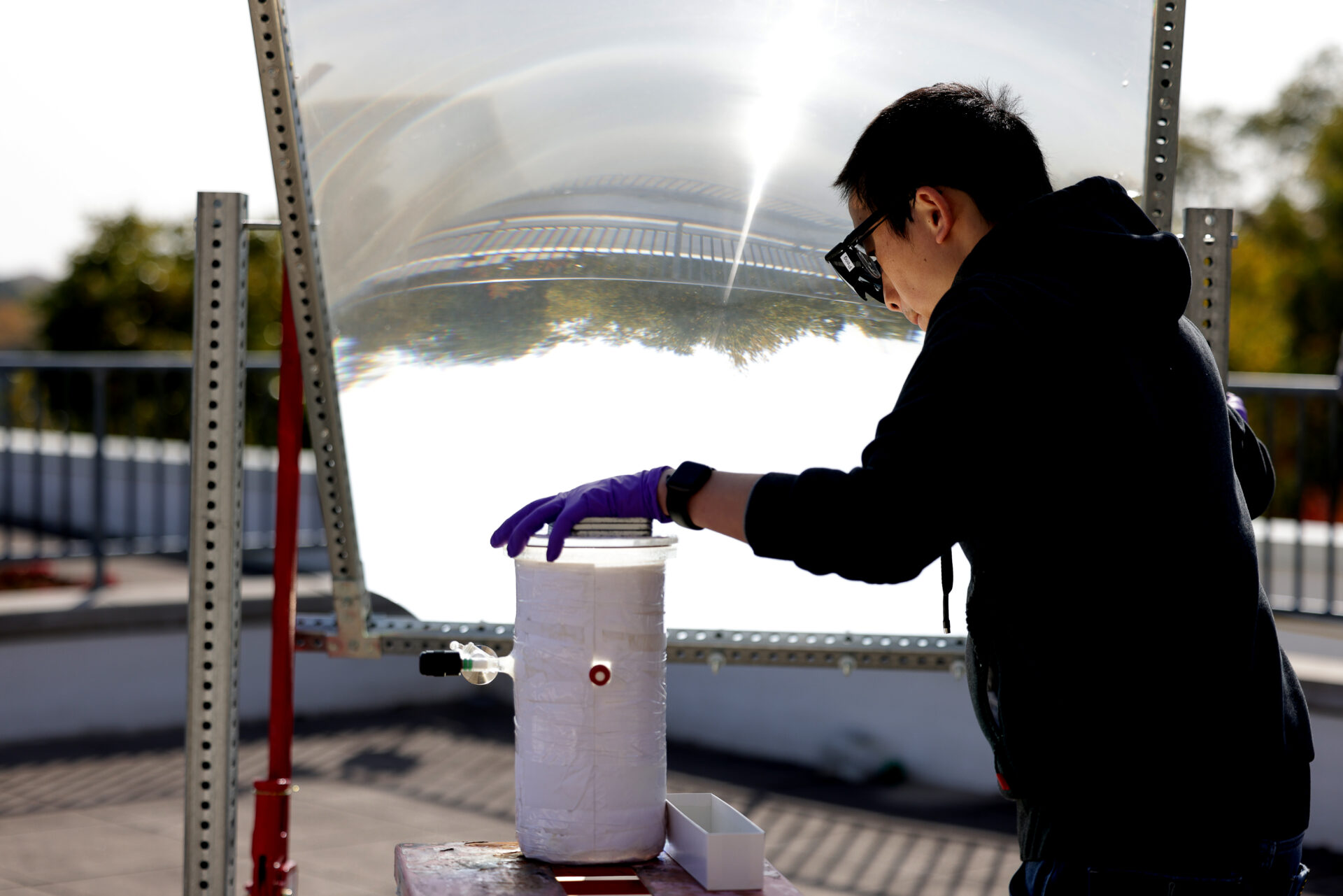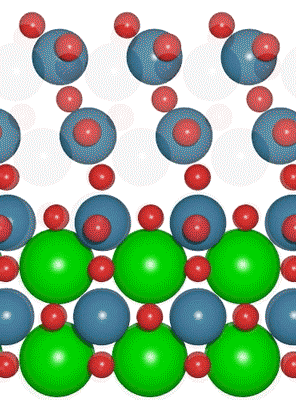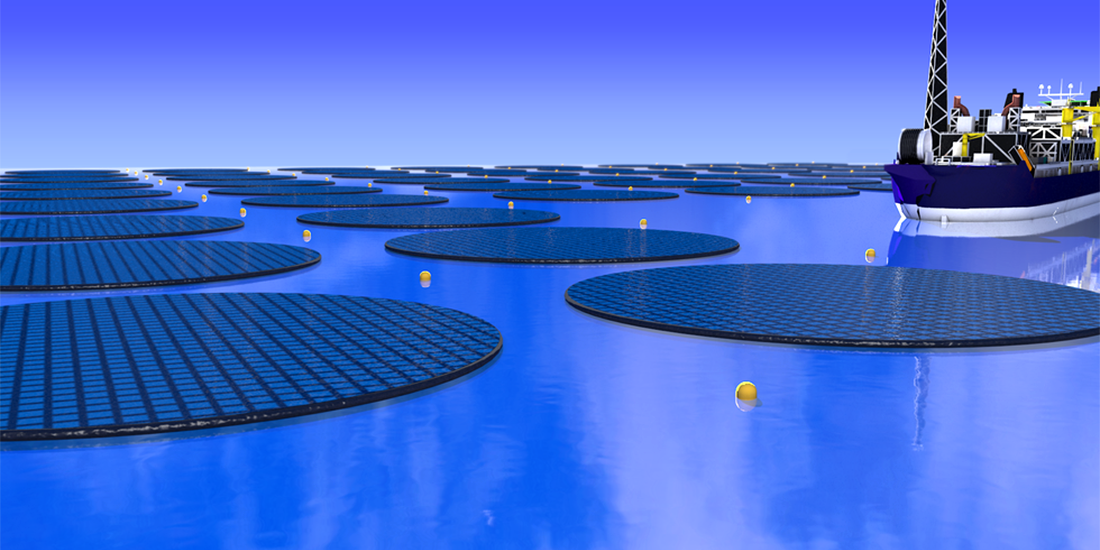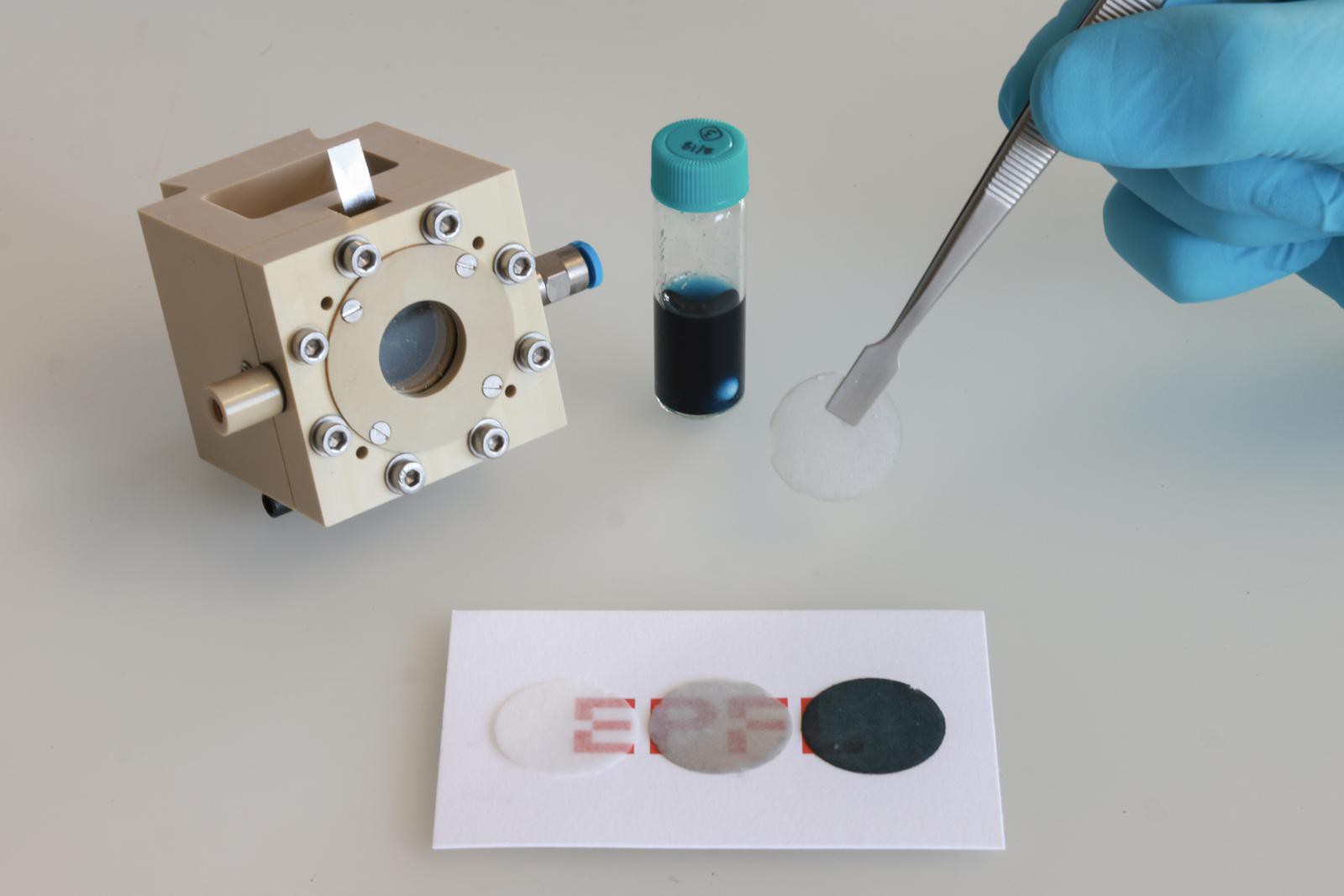
Peng Zhou uses a large lens to concentrate sunlight onto the water-splitting catalyst. Outdoors, the device was ten times more efficient than previous efforts at solar water splitting.
Photo: Brenda Ahearn/Michigan Engineering, Communications and Marketing
Withstanding high temperatures and the light of 160 suns, a new catalyst is 10 times more efficient than previous sun-powered water-splitting devices of its kind
A new kind of solar panel, developed at the University of Michigan, has achieved 9% efficiency in converting water into hydrogen and oxygen—mimicking a crucial step in natural photosynthesis. Outdoors, it represents a major leap in the technology, nearly 10 times more efficient than solar water-splitting experiments of its kind.
But the biggest benefit is driving down the cost of sustainable hydrogen. This is enabled by shrinking the semiconductor, typically the most expensive part of the device. The team’s self-healing semiconductor withstands concentrated light equivalent to 160 suns.
Currently, humans produce hydrogen from the fossil fuel methane, using a great deal of fossil energy in the process. However, plants harvest hydrogen atoms from water using sunlight. As humanity tries to reduce its carbon emissions, hydrogen is attractive as both a standalone fuel and as a component in sustainable fuels made with recycled carbon dioxide. Likewise, it is needed for many chemical processes, producing fertilizers for instance.
“In the end, we believe that artificial photosynthesis devices will be much more efficient than natural photosynthesis, which will provide a path toward carbon neutrality,” said Zetian Mi, U-M professor of electrical and computer engineering who led the study reported in Nature.
The outstanding result comes from two advances. The first is the ability to concentrate the sunlight without destroying the semiconductor that harnesses the light.
“We reduced the size of the semiconductor by more than 100 times compared to some semiconductors only working at low light intensity,” said Peng Zhou, U-M research fellow in electrical and computer engineering and first author of the study. “Hydrogen produced by our technology could be very cheap.”
And the second is using both the higher energy part of the solar spectrum to split water and the lower part of the spectrum to provide heat that encourages the reaction. The magic is enabled by a semiconductor catalyst that improves itself with use, resisting the degradation that such catalysts usually experience when they harness sunlight to drive chemical reactions.
In addition to handling high light intensities, it can thrive in high temperatures that are punishing to computer semiconductors. Higher temperatures speed up the water splitting process, and the extra heat also encourages the hydrogen and oxygen to remain separate rather than renewing their bonds and forming water once more. Both of these helped the team to harvest more hydrogen.
For the outdoor experiment, Zhou set up a lens about the size of a house window to focus sunlight onto an experimental panel just a few inches across. Within that panel, the semiconductor catalyst was covered in a layer of water, bubbling with the hydrogen and oxygen gasses it separated.
The catalyst is made of indium gallium nitride nanostructures, grown onto a silicon surface. That semiconductor wafer captures the light, converting it into free electrons and holes—positively charged gaps left behind when electrons are liberated by the light. The nanostructures are peppered with nanoscale balls of metal, 1/2000th of a millimeter across, that use those electrons and holes to help direct the reaction.
A simple insulating layer atop the panel keeps the temperature at a toasty 75 degrees Celsius, or 167 degrees Fahrenheit, warm enough to help encourage the reaction while also being cool enough for the semiconductor catalyst to perform well. The outdoor version of the experiment, with less reliable sunlight and temperature, achieved 6.1% efficiency at turning the energy from the sun into hydrogen fuel. However, indoors, the system achieved 9% efficiency.
The next challenges the team intends to tackle are to further improve the efficiency and to achieve ultrahigh purity hydrogen that can be directly fed into fuel cells.
Original Article: Cheap, sustainable hydrogen through solar power
More from: University of Michigan
The Latest Updates from Bing News
Go deeper with Bing News on:
Sun-powered water-splitting devices
- Power Up Anywhere With These Solar Chargers
Pack a solar charger for the trip and suddenly you’ve got the world back at your fingertips. These portable gadgets marry solar panels with battery packs—they’re small and lightweight enough to not ...
- Solar Energy News
Apr. 8, 2024 — Researchers have fabricated a new four-terminal organic solar cell with a tandem configuration with a 16.94% power conversion efficiency (PCE). The new device is composed by a ...
- Toward artificial leaves that float on water, bubbling fuel
Researchers have now made such an artificial leaf device using an organic photovoltaic (OPV) material. Depending on the catalyst used, the device either splits water to make hydrogen fuel or splits ...
- The Best Solar Generators for at Home or On the Go, Tested
Harnessing the sun ... to power larger appliances, such as refrigerators, dishwashers, washing machines, hot water heaters, and sump pumps, or may not be capable of powering multiple devices ...
- Power from Sunshine
The power of this first plant is used for pumping water by means of a reciprocating steam pump of the ordinary type, and whenever the sun has shone ... the other on a device for testing cereals ...
Go deeper with Bing News on:
New kind of solar panel
- CHINT and PVH enhance their position in global solar market with strategic alliance
CHINT New Energy (CHINT) and PV Hardware (PVH) celebrated a significant milestone with the signing of a Strategy Cooperation Agreement on April 8th in Shanghai. Mr. Martin Liu, Director of Overseas ...
- Scams proliferate alongside solar buildout
Financial scams have accompanied loan programs meant to help households finance the installation of energy-saving tech.
- Balcony solar panel systems gain popularity for their portable convenience — here's how they work
A new type of solar panel system is gaining popularity in Germany, and you won't find it on a roof. Plug-in solar balconies are providing a cheaper and cleaner energy source that's also portable.
- DualSun Introduces All-in-One Solar Panels That Don’t Need Installation
France-based company DualSun, which makes solar panels that also work as water heaters, has introduced a new type of solar kit that can be folded up. These kits are designed for homes and outdoor ...
- Ask the I-Team: What happens to Maine solar panels when they no longer work?
ReVision Energy, one of the leading solar installers in Maine, tells the I-Team that for the miniscule amount of panels at the end of their life already, ReVision Energy will remove and repurpose them ...










